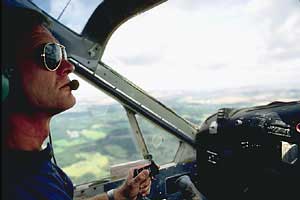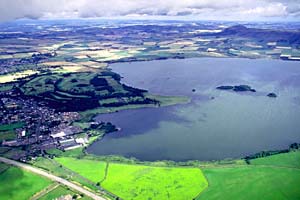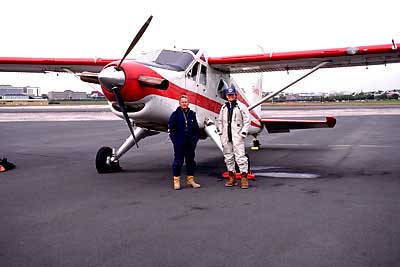![]()
Aberdeen Scotland: Forth Fuel Stop
![]() The "Brits" at Southampton were extremely friendly and helpful.
The dispatcher prepared a full VFR flight plan and accompanying map so we
could avoid the busiest centers. Klaus flew this VFR leg as his instrument
rating wasn't current. That would give him some stick time including the
take off. Plus, I wanted some time to take photographs of the landscape
below.
The "Brits" at Southampton were extremely friendly and helpful.
The dispatcher prepared a full VFR flight plan and accompanying map so we
could avoid the busiest centers. Klaus flew this VFR leg as his instrument
rating wasn't current. That would give him some stick time including the
take off. Plus, I wanted some time to take photographs of the landscape
below.

Low clouds and rising terrain kept us
within
sight of castles, stone hedges, canals, and sheep.
![]() We mostly navigated by ONC maps, but the control towers were very helpful
in providing vectors. Our beaver did not have a transponder, but they had
us anyway. There is no shortage of precision radar in Britain.
We mostly navigated by ONC maps, but the control towers were very helpful
in providing vectors. Our beaver did not have a transponder, but they had
us anyway. There is no shortage of precision radar in Britain.
![]() In fact,
ATC kept vectoring us overhead the airports. I thought it was to keep
better track of our movements, and that was partly right. The real reason
revealed itself when one controller asked us, "Was that turbine
conversion done in the factory, or was it a retrofit?" And another
asked us, "Is that the DHC-2T MarkIII? It doesn't look like the
radial engine." Since I had filed the flight plan as DHC-2 the only
way they would have known was by having a good look with binoculars. That
is why they had to vector us closer!
In fact,
ATC kept vectoring us overhead the airports. I thought it was to keep
better track of our movements, and that was partly right. The real reason
revealed itself when one controller asked us, "Was that turbine
conversion done in the factory, or was it a retrofit?" And another
asked us, "Is that the DHC-2T MarkIII? It doesn't look like the
radial engine." Since I had filed the flight plan as DHC-2 the only
way they would have known was by having a good look with binoculars. That
is why they had to vector us closer!
![]() Just to
see the world I had read so much about in English history and literature
was an intellectual thrill. I had driven around the entire island one time
by car, but to view it all from above was, to me, the equivalent of time
travel. I could visualize the years passing by.
Just to
see the world I had read so much about in English history and literature
was an intellectual thrill. I had driven around the entire island one time
by car, but to view it all from above was, to me, the equivalent of time
travel. I could visualize the years passing by.
![]() I can see
the highway men, waiting behind the hedge row along the winding road. I
can see the footpaths worn during the years Coleridge walked the land
reciting his latest drug induced poem to his soul searching friend.
"Water water everywhere and all the boards did shrink. Water water
everywhere nor any drop to drink." And worse yet, the turbo-beaver
with no floats!
I can see
the highway men, waiting behind the hedge row along the winding road. I
can see the footpaths worn during the years Coleridge walked the land
reciting his latest drug induced poem to his soul searching friend.
"Water water everywhere and all the boards did shrink. Water water
everywhere nor any drop to drink." And worse yet, the turbo-beaver
with no floats!

There is definitely enough water around
for the
Turbo-Beaver, if we only had floats!
![]() The castles of the Red Rose, the moats and drawbridges, the huge old
mansions haunted by some deceased Earl or Duke, the frozen canals of the
Great Frost, the oak forests of Robin Hood, the fertile landscape of the
Lake District, and the highlands of "Rob Roy" that had
previously only existed in the imagination of my visual memory were now
real before me.
The castles of the Red Rose, the moats and drawbridges, the huge old
mansions haunted by some deceased Earl or Duke, the frozen canals of the
Great Frost, the oak forests of Robin Hood, the fertile landscape of the
Lake District, and the highlands of "Rob Roy" that had
previously only existed in the imagination of my visual memory were now
real before me.

Mansions of the Jane Erye era.
![]() The illusion of ancient mariners and artful dodgers, however, was spoilt
by the monstrosities of the nuclear reactors and their masses of powerline
grids. Our storm scope fell victim to the enormous energy coming from the
gridlines as we passed overhead after erroneously reading huge lighting
storms nearby. Those monster concrete towers made me nervous.
The illusion of ancient mariners and artful dodgers, however, was spoilt
by the monstrosities of the nuclear reactors and their masses of powerline
grids. Our storm scope fell victim to the enormous energy coming from the
gridlines as we passed overhead after erroneously reading huge lighting
storms nearby. Those monster concrete towers made me nervous.
![]() Just as we
were getting into the Yorkshire Dales, ATC calls us to say that we will be
seeing fast moving low level VFR traffic passing underneath of us. That is
difficult to believe because we are only at 700 feet above the terrain.
Sure enough, a creme color Alphajet comes tearing out from around a hill
parting the grass beneath us.
Just as we
were getting into the Yorkshire Dales, ATC calls us to say that we will be
seeing fast moving low level VFR traffic passing underneath of us. That is
difficult to believe because we are only at 700 feet above the terrain.
Sure enough, a creme color Alphajet comes tearing out from around a hill
parting the grass beneath us.
![]() The
population of Manchester and the working canals merge into Windermere and
the picturesque Lake District, and Carlisle passes by as we head into the
highlands. The tops of the hills protrude into the alternating dark gray
and bright white stratus cloud ceiling. We have to navigate around the
hills. ATC warns us that they will lose us from radar and we will have to
continue on our own until we get into Glasgow radar. Klaus and I are not
particularly worried as we weave our way through the highland moors
buzzing sheep and sheepherders alike. None of them appear bothered either.
The
population of Manchester and the working canals merge into Windermere and
the picturesque Lake District, and Carlisle passes by as we head into the
highlands. The tops of the hills protrude into the alternating dark gray
and bright white stratus cloud ceiling. We have to navigate around the
hills. ATC warns us that they will lose us from radar and we will have to
continue on our own until we get into Glasgow radar. Klaus and I are not
particularly worried as we weave our way through the highland moors
buzzing sheep and sheepherders alike. None of them appear bothered either.

Can anyone envision the Northern tribes
roaming these Scottish Moors? What for?
![]() We break out of the highlands to fly over the Firth of Forth river reach
near Edinburgh. Klaus and I are slightly concerned that our destination
airport will give us a hard time. We were supposed to file a request to
enter their zone with some specific notice. The airport is the jumping off
point for the helicopters heading off to the North Sea oil fields and the
clearance is to fit us into the busy traffic pattern. When we give Aberdeen a
call we get no queries and in fact the airport is not all that busy. There
are some helicopters coming and going, but we have no problem fitting into
the traffic pattern.
We break out of the highlands to fly over the Firth of Forth river reach
near Edinburgh. Klaus and I are slightly concerned that our destination
airport will give us a hard time. We were supposed to file a request to
enter their zone with some specific notice. The airport is the jumping off
point for the helicopters heading off to the North Sea oil fields and the
clearance is to fit us into the busy traffic pattern. When we give Aberdeen a
call we get no queries and in fact the airport is not all that busy. There
are some helicopters coming and going, but we have no problem fitting into
the traffic pattern.

The City of Edinburgh.
Correct me if I am wrong.
![]() The arrangements we had made before we left Nigeria, was for the company
Bristow Helicopters to help us in getting our aircraft and ourselves fit
for the Trans-Atlantic crossing. The ferry fueling system in the aircraft
needed fixing properly. We were still only getting half the flow we needed
to refill the main tanks from the ferry tanks. Basically we needed to
replace that homemade fuel bung fitting we had rigged in Nigeria hours
before our flight. Plus, we needed the avionics fixed in order to do a
proper IFR Atlantic crossing. No more bluffing.
The arrangements we had made before we left Nigeria, was for the company
Bristow Helicopters to help us in getting our aircraft and ourselves fit
for the Trans-Atlantic crossing. The ferry fueling system in the aircraft
needed fixing properly. We were still only getting half the flow we needed
to refill the main tanks from the ferry tanks. Basically we needed to
replace that homemade fuel bung fitting we had rigged in Nigeria hours
before our flight. Plus, we needed the avionics fixed in order to do a
proper IFR Atlantic crossing. No more bluffing.

British air traffic controllers kept
vectoring us over their fields.
To get a better look at the Turbo-Beaver!
For ourselves, we needed to get completely outfitted with immersion suits and warm clothing. Up until now the longest water crossings had been the Mediterranean Sea and the English Channel. Although we were doing the Atlantic in three stages it could be 10-12 hours of over water flying if we had to divert or turn back because of weather. We wanted to be safe and warm. Somehow after getting the suits and having our first look at the frigid waters below during our crossing, I could not imagine being either safe or warm if we had to ditch.

We spent two days getting fitted for our
immersion suits.
Survival of the outfittest! Ready for the ocean crossing.
Story and Images by John S Goulet
![]() Reykjavik
Iceland Crossing the cold North Sea to the
Reykjavik
Iceland Crossing the cold North Sea to the
![]() heat of
active volcanoes.
heat of
active volcanoes.
![]()
Note from the Editor.![]() Follow the progress of the Turbo-Beaver as we fly our way back to
Canada. The attitude indicator will take you back to the ferry flight introduction page.
Follow the progress of the Turbo-Beaver as we fly our way back to
Canada. The attitude indicator will take you back to the ferry flight introduction page.
Where all our flying is cross country.
Last modified on April 21th, 2013.
© Virtual Horizons, 1996.
